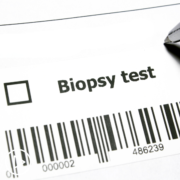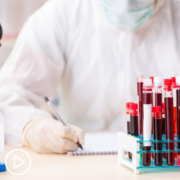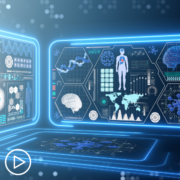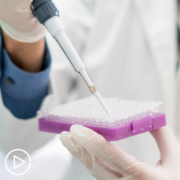AML Treatment Approaches | Factors That Impact Options from Patient Empowerment Network on Vimeo.
What factors are considered when choosing an AML treatment approach? Dr. Ann-Kathrin Eisfeld explains how shared decision-making comes into play when deciding on a therapy and reviews the options available to treat AML.
Dr. Ann-Kathrin Eisfeld is Director of the Clara D. Bloomfield Center for Leukemia Outcomes Research at The Ohio State University and a member of the Leukemia Research Program at the OSUCCC – James. Learn more about Dr. Eisfeld.
See More From INSIST! AML
Related Resources:
Transcript:
Katherine Banwell:
With all the new tools that are available, what other factors do you consider when working with an AML patient to choose a treatment approach for them?
Dr. Eisfeld:
The most important aspects are what we call – and this is – I’m glad that you bring this question up because I feel you have to think of – and that was what we’ve been talking about – called disease-associated factors. This is everything in the leukemic cell. They – how does a leukemia looks like? How does the blast look like? What changes are there?
That’s the biggest part of what I would call patient-associated factors: the patient age, the patient performance status, actually the patient. In every – because I think, sometimes, we forget about it. But we just look at all the molecular testing.
But even if – for example, there would be a patient with a very good risk leukemia, where I think, “Oh, this leukemia should respond very well to an intensive chemotherapy.”
If the patient cannot tolerate chemotherapy or – and I see it more often than I would wish for patients who are young who have a great performance status, but they just cannot – they – their family reasons. Small children sometimes – they just cannot be away for so long. This all comes into consideration. So, it’s really important because we all work together as a team. And the right treatment for the leukemia might not be the right treatment for the patient.
And for most cases, however, I think, it will only work if one stands with a whole heart with both physicians, and patients, and family. Because it’s a long journey behind the care that’s being given. And so, this is a joint decision-making, and there are different options that can be done. Of course, I would not advise something where I would think there are no chances of success.
And so, this has to be an open discussion. But this is – it’s very often a very tough treatment to communicate that and see what are the goals of each patient? That will be most important for treatment and decision-making.
Katherine Banwell:
What types of AML treatment classes are currently available?
Dr. Eisfeld:
This is a very good question. The most classic treatment class is intensive chemotherapy. This is just because people might have heard the names. It is called 3 + 7 or 7 + 3, which refers to one weeklong impatient chemotherapy treatment. But you get one chemotherapy for seven days. And the first three days, you get a second treatment as well.
That’s why it’s called three in seven in here, but it’s a total of seven days. So, we have intensive chemotherapy. And there are different flavors of it. But this is usually the backbone. The second class is what I would call a targeted inhibitor. And here we can look at two different aspects. We have targeted inhibitors for a specific DNA mutation that are found. And specifically, one are called IDH or FLT3 mutations.
And these are pill forms that I usually by now combined with a third drop class which is called hypomethylating agents. And I will go through in a moment.
But these are pills that really only work in patients and carry that genetic change. They have very, very low toxicity and very high chances of working. So, that’s why this testing is so important to see if one is one of the 15 percent of AML patients carrying an IDH mutation – 15 percent isn’t low. And a similar rate carries a FLT3 mutation.
And then there is also going to target inhibitors. That is targeted because it is against what I would call a pathway. The gene that is commonly activated in acute leukemia – and this is called BCL-2 and the drug is called venetoclax (Venclexta).
This is now stormed through the acute myeloid leukemia world in just a few years ago and has been approved as a front-line treatment option for several patients, especially for those who are older. And we know that even patients who respond usually favorably to chemotherapy, some of those also respond well to venetoclax the Bcl-2 inhibitor. The benefit is that this treatment in many cases if it works, can be done as an outpatient in here and has very often lower complications.
It is actually has so good results that I – sometimes it seems too easy. So, we actually advise patients to still try to get – the first time they get the treatment, do it at a center where it’s done more commonly. Because it sometimes – don’t underestimated the power of a pill. And it’s still a very, very powerful drug. So, doing it in a controlled setting – because if cancer cells break down, they break down and can create all sorts of trouble.
So, that is really something – for several leukemias, it can be concerning. And again, now the treatment group would be called hypomethylating agents. The names are azacitidine (Vidaza) and decitabine (Dacogen). And they act in a very different way. They try to change the epigenetics like methylation patterns. And often, if it is an untargeted way of the tumor cells and they can be used alone.
Or very often by now in combination with the targeted inhibitors that I was just mentioning. These are infusions that can be done either over five, seven, or 10 days depending on the combination treatment. And for patients, as I mentioned before, that don’t respond well to many other options to those patients with a complex karyotype. This is, for example, a scenario where patients can just receive this as their only therapy.
Katherine Banwell:
What about stem cell transplant? You didn’t mention that.
Dr. Eisfeld:
Yes. That would be the next one. So, stem cell transplant always comes as an option, which I would call as a maintenance therapy. Again, two aspects. We have two different end goals.
First is get rid of some leukemia. Second is to make sure it stays away. And as soon as the leukemia is in complete remission, depending on the performance status – the agent. Again, in multiple different things. It’s not an easy decision.
At that time, there has to be a conversation. And that always involves a leukemia physician and a transplant physician very often. These are different providers that goes for the risks and benefits. Where the question is if I only continue to do chemotherapy – because it’s never only once. You would always have to repeat your chemotherapy. What is the likelihood that the leukemia comes back, and does it outweigh the risks that comes with the stem cell or bone marrow transplant that comes in here. But for many leukemias, especially for young patients and for patients with higher risks, this is the only chance of a cure. That is the most curative and only curative attempt for many leukemia attempts.
Katherine Banwell:
Where do clinical trials fit into the treatment plan?
Dr. Eisfeld:
That is the absolute backbone. We always have to think about that.
Everything – all the treatment options that I mentioned – have been clinical trials, just very, very short time – very few years ago. So, every patient that comes to a leukemia or a cancer center, clinical trials will be discussed if they’re available. Because they will provide a special opportunity to have even more fine-tuned treatments – either newer agents. And I think what is very important to mention is that all clinical trials that are available would give the option of the best standard of care.
And then the hope that a patient wouldn’t be getting any of the best standard of care options that are approved. The hope is that the new agent or added agent in many cases would even do better.
It’s also important that there’s a lot of additional monitoring during the trial. I think it can be seen in two ways as two parts of a coin. In one way, it may be additional visits to the hospital or additional blood draws that are necessary to be sure that the medications are safe, and that researchers and conditions can learn about it. But on the other hand, it also gives you this extra bit of being looked after and really getting checked in and out, making sure that all organs are functioning that everything is just going fine. And many patients appreciate this a lot. And they have this pair of extra eyes on them all the time.
Katherine Banwell:
Dr. Eisfeld, what therapies are available for AML patients who relapse or don’t respond to initial therapy? And is this treatment approach different from those who are newly diagnosed?
Dr. Eisfeld:
Most of the time, the treatments available at relapse are the same available at the first diagnosis. Just because we know now that, for example, if you have a molecular marker that, for example, is available, it would act with also relatively high chance of relapse upset. However, at relapse, the most important thing I personally would do is consider a clinical trial even stronger than in the first mindset.
Because it means that the leukemia outsmarted current treatments very often. So, usually what we would be doing is see if there is a targeted inhibitor or a cell mutation FLT3 or IDH, which I would personally always prefer to go in MLL rearrangement now for the new menin inhibitors where one would go with the same option as if it would have been their diagnosis. But if not to really consider clinical trials is a strong urge.
Katherine Banwell:
Should patients or should relapsed patients undergo genetic testing again? Is it necessary?
Dr. Eisfeld:
Yes. At any time. Yes. Because we know that the leukemia changes. And you just can think about it in the way is that the cells that are surviving treatment, they’ve become smart. There was so much poison. There was so much treatment put on them.
And the ones that survive might have a quiet additional chromosome change as additional gene changes. And even if a genetic change has not been present at time of diagnosis, the reason the cell has survived might have been that it has now one of these changes that came up on a later time during treatment or while the cell is hiding somewhere to come back.












